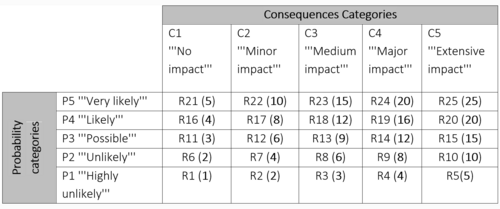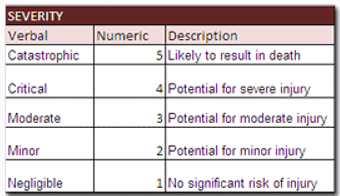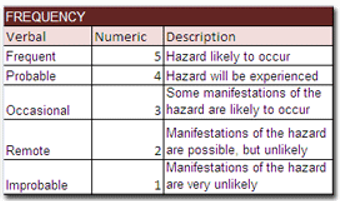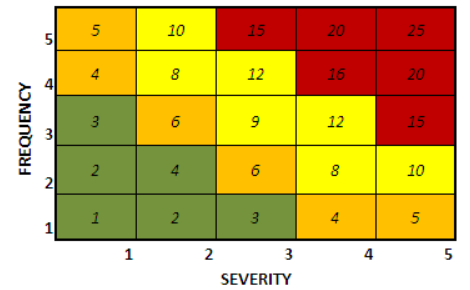Risk matrix
To successfully execute its projects, especially in surrounding unstable environment, the companies, need to be aware about significant uncertainties, which will undoubtedly face projects during different stages of its life cycle regardless its complexity and time completion.
The uncertainties imply risks of (generally adverse) events those effect on the outcome or/and objectives of projects. In order to understand the variety of risks that a project face Risk Management activities in a project need to be performed. Effective project management need to identify what types of risk may influence particular stage of project. Furthermore, the management have to analyze and prioritize risks in terms of most severity and perform decision making in order to treat the risk and finally treat relevant risks in a structured way in order to avoid or at least mitigate any harm that may cause this certain risk.
However, how to decide and prioritize which risk is more dangerous and need to be treat first?
The one of the useful risk assessment tool supports project management to decide which risk need to be consider at first called “Risk Matrix” or also known as “Probability and Impact Matrix”.
Risk Matrix (Probability and Impact Matrix) is a broadly used risk assessment tool to define the different levels of risk as the product of the harm probability categories and harm severity categories. [1]
It is a common graphical tool used to simply and quickly visualize and categorize already identified risks, source of risks or risk treatments based on its probability and impact on a project. [1]
The aim of current article is to give an overview and summary of Risk Matrix. At the beginning, the article will provide briefly introduction to the risk management with its important elements. and the core idea of the risk matrices. Furthermore the article will defined the applications of presented tool as well as a practical usage within Project Management activities. Finally, the strengths and limitations of presented tool will determined and outlined.
Contents |
Introduction and main idea
Any projects during its different lifecycle stage are facing a variety of risks, defined as state of uncertainty where some possible outcomes have an negative effects on objectives, significant loss or other adverse or unwelcome circumstance.
Effective project manager need to be aware about potential types of risks in order to response and prevent unexpected event. This can be achieved by risk assessment process (shown in figure 1) which “aims to improve decision making process by identifying, assessing and mitigating relevant risks in a structured way” [2] The detailed description of Risk Assessment process is beyond the scope of this article, but for the deeper insight please follow the link Risk Assessment where the all relevant information can be found). Each of these activities is very comprehensive and takes a huge amount of resources, money and time consumption. Thus, in order to balance cost, time and resource of particular project, the management have to prioritize risks instead of trying to address each and every risk that particular project might face.
The one of the very useful risk assessment tool supports project management to decide which risk need to be consider at first called “Risk Matrix” or also known as “Probability and Impact Matrix”.
Risk Matrix (Probability and Impact Matrix) is a broadly used risk assessment tool to define the different levels of risk as the product of the harm probability categories and harm severity categories.
The main aim of risk matrix is to classify and prioritize hazard of adverse events based on the level of risk in order to facilitate management to make decision whether certain risks can be admit or whether not. [3]
According to ISO 31000 [4]the definition of risk outlined as combination of two basis criteria:
- The consequences or the severity of the impact of an adverse event caused by the risk.
- The probability or likelihood that this event may occur
In its turn the level of risk or risk value is defined as multiplication of these two criteria
"Level of Risk=Probability x Consequence”[3]
The combination of these parameters created risk matrix as two-dimension grid with consequence/impact on one axis (commonly X-axis) and probability or likelihood on the other (Y-axis) as shown on figure 2.
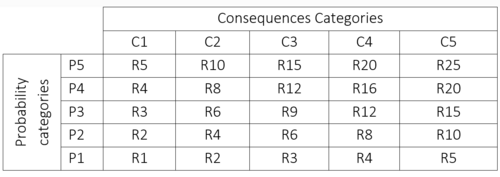
The severity or consequences scale describes the range of different types of impact of the adverse events that, if it occurs, will have an effect on the objectives and/or values such as physical health, social status, emotional well-being or financial wealth [5]
The consequence scale are commonly extended from the lowest potential impact to the highest as illustrated in figure 02 and can comprise any number of criteria with nominal or textual description such as ““No impact”, “Minor”, “Medium”, or “C1”, “C2”, “C3” and etc.
The example of possible consequences criteria can defined as follows:
1. No impact: Limited hazard that will cause a near insignificant amount of harm to the overall progress of the project.
2. Minor impact: A minor hazard which lead to less significant extent of harm which in its turn not cause of a difference to the overall progress of the project are classified as minor risk.
3. Medium impact: Moderate hazard which do not imply a huge harm, though yet a considerable harm portrayed as medium.
4. Major impact: Critical risks with significantly large impact that may lead to a huge amount of loss or harm identified as major.
5. Extensive impact : The most adverse hazard that lead to a catastrophic consequences such as high amount of lives losses or harm that totally destroyed a project (for example tsunami) is outlined as extensive impact.
The other dimension of risk matrix is the likelihood scale describes the range of probability of the occurrence of a risk. As the consequence scale, the probability scale is also extended from the lowest potential likelihood to the highest as portrayed in figure 02 and comprised variety numbers of criteria with nominal or textual description such as ““High unlikely”, “Unlikely”, “Possible”, or “P1”, “P2”, “P3” and etc.
The example of possible probability criteria can outlines as follows:
1. Highly unlikely: Unlikely risks, which have a rare level occurrence such as less than 10%.
2. Unlikely: Seldom risk contains low probability of occurrence however cannot yet excluded entirely.
3. Possible: Hazard, which have occasional (50/50) likelihood of occurrence harm
4. Likely: Risks that lies among 60-80% chances of occurrence can be grouped as likely.
5. Very likely: A definite hazard that has highest frequency (generally more than 80 %) of reveal during certain project stages. [6]
The definition of both criteria consequence and probability scales could vary in different organization and project areas, thus it is worth mentioning that mentioned above descriptors is recommended as a guide only. Finally, based on combination of probability and impact the level of risk can easily counted and ranked by placing adverse event into risk matrix according to assigned consequence and probability as shown on figure 3
As example the undesired event R25 displayed on the figure 3 has the highest risk value equal to “25”, or the risk R22 and R10 have the identical risk value ”10”.
Application and use
1. Application
‘Risk matrices have two main applications. The application or aim of the risk matrix is relevant when discussing the suitability of risk matrices. One application is decision-making about the acceptance of risk; the other is to prioritize which risk needs to be addressed first.
Frequently, in risk acceptance, only three levels of risk are distinguished:
- hazards or events with unacceptable risk (often indicated with a red color);
- hazards or events in which the risk is found to be ‘‘broadly acceptable’’, i.e. not requiring further risk reduction (often indicated with green),
- an intermediate level, where risk should be reduced ‘‘As Low As Reasonably Practicable’’ (ALARP, often indicated with yellow).
Given these interpretations, there is no need to further prioritize hazards, at least not in the red and green areas.
In cases where the risk matrix is used for prioritizing (which hazards require most attention in order to reduce the cumulative risk), a larger number of risk levels may be necessary in order to obtain sufficient resolution to rank events or hazards in order of priority.
2. Usage of Risk matrix
The usage of Risk matrix can be determines into five steps as follows: [7]
Learning to Prioritize Risks
1. Identify and assess the severity of the impact of an adverse event caused by the risk as illustrated in figure xx.
Figure xx: Severity of the impact [8]
2. Estimate the probability of each risk occurring, and assign it a rating as portrayed in figure xx
Figure xx: Probability of the risk [8]
3. Explore and map on the level of risk on the Risk Matrix as shown in figure xx
"Level of Risk=Probability x Consequence”[9]
Figure XX Risk matrix with estimated level of risk [8] [10]
4. Develop a response to each risk, according to its position in the chart. Remember, risks in the bottom left corner can often be ignored, while those in the top right corner need a great deal of time and attention
5. Based on the level of risk the user makes decision which certain risks can be tolerated or not. [8]
For example, in shown example (figure XX) the rank of level of risk up to 4 can be ignored, between 5-12 need to be take into further risk analysis in terms of mitigation of the risk and the rank more than 15 is classified as not acceptable.
Limitations
The aim of any risk evaluation tool is to ensure that the decision process is transparent, based on best knowledge and reflects the common understanding of stakeholders. When reviewing the application of risk matrices, it becomes obvious that this simple tool has some notable weaknesses. Both users and designers of risk matrices should be aware of these shortcomings and ensure that the risk matrices are used in such a way that correct conclusions are drawn.
The mentioned ISO 31010 [1] also includes an invaluable summary of the advantages and disadvantages of risk matrices, together with recommendations for their usage.
Strengths:
- relatively easy to use;
- provides a rapid ranking of risks into different significance levels.
Limitations:
- a matrix should be designed to be appropriate for the circumstances so it may be difficult to have a common system applying across the range of circumstances relevant to an organization;
- it is difficult to define the scales unambiguously;
- use is very subjective and there tend to be significant variation between raters;
- risk can not be aggregated (i.e. one cannot define that a particular number of low risks or a low risk identified a particular number of ties is equivalent to a medium risk);
- it is difficult to combine or compare the level of risk for the different categories of consequences(impact)
Results will depend of the level of detail of the analysis, i.e. the more detailed the analysis the higher the number of scenarios, each with a lower probability. This will underestimate the actual level of risk. The way in which scenarios are grouped together in describing risk should be consistent and defined at the start of the study. [1]
Annotated bibliography
For further reading on the subject or related subjects, the reader is encouraged to check out the following:
- Nijs Jan Duijm (2015), Recommendation on the use and design of risk matrix, Safety Science 76, DTU, Denmark .[3]
- “The article explore the weakness of risk matrices and provide recommendation for the use and design of risk matrix
- ALARP [11]
- “The wiki-article describes a term often used in the milieu of safety-critical and safety-involved systems.
- Risk Management [12]
- The wiki-article describes the concept of the identification, assessment, and prioritization of risks followed by coordinated and economical application of resources to minimize, monitor, and control the probability and/or impact of unfortunate events or to maximize the realization of opportunities
- Risk Management - Risk assessment techniques, Dansk Standart DS/EN ISO 31010, 2010
- The international standard (ISO) 31010 contains guidance on selection and application of systematic techniques for risk assessment. .
Videos
A short video to visualyse the usage and benefits of Risk Matrix as explained in the article.
References
- ↑ 1.0 1.1 1.2 1.3 1.4 1.5 [Risk Management - Risk assessment techniques] Dansk Standart DS/EN ISO 31010, 2010
- ↑ [How to Do Projects”] “JoanaGeraldi, Chrisitan Thuesen, JosefOehmen, Textbook DTU 2016
- ↑ 3.0 3.1 3.2 3.3 [Recommendation on the use and design of risk matrices'] Nijs Jan Duijm, Safety Science 76, p.21-31, DTU, 2015
- ↑ [Risk Management – Principles and Guidelines] Dansk Standart DS/EN ISO 31000, 2009
- ↑ [Risk Definition'] https://en.wikipedia.org/wiki/Risk
- ↑ [A Critical Tool for Assessing Project Risk] http://www.brighthubpm.com/risk-management/88566-tool-for-assessing-project-risk/#imgn_0
- ↑ [Learning to Prioritize Risks] https://www.mindtools.com/pages/article/newPPM_78.htm
- ↑ 8.0 8.1 8.2 8.3 [Usase of risk matrices]http://blog.etq.com/bid/57768/Risk-Assessment-Creating-a-Risk-Matrix
- ↑
- ↑ [Keeping Track of Risks With a Project Risk Matrix]http://www.brighthubpm.com/risk-management/96973-keeping-track-of-risks-with-a-project-risk-matrix/
- ↑ Cite error: Invalid
<ref>tag; no text was provided for refs namedalarp - ↑ Cite error: Invalid
<ref>tag; no text was provided for refs namedRM
